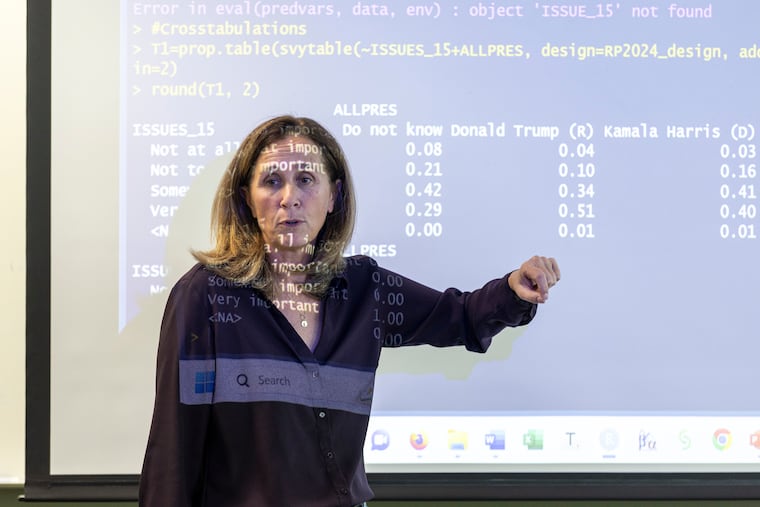A West Chester professor and her class polled students statewide about the election. Here’s what they found.
Most reported they will vote, and a majority favor Vice President Kamala Harris

Laura Pyott, like many, was caught off guard in 2016 when Donald Trump beat Hillary Clinton for the presidency in Pennsylvania after many polls showed her winning, in some cases by double digits.
A statistician by trade, the West Chester University assistant professor began investigating.
“I thought it could be an interesting class,” she said.
This year, for the fourth time, Pyott and the students in her Statistical Methods for Political Polling class conducted their own poll. They surveyed students at West Chester and the other nine universities in the Pennsylvania State System of Higher Education about the upcoming presidential election.
» READ MORE: College students could have big sway in this election. Here’s how Philly-area campuses are turning out.
Some interesting findings emerged:
Nearly 95% of the 1,048 respondents said they will probably or certainly vote or already have voted, up from 89% in 2022, and 86% in 2020. While Pyott was encouraged by the record enthusiasm, she said she thinks students interested in the election were the ones most likely to take the poll, so results could be skewed. “We ran into the same issue that a lot of pollsters are running into, and it’s this concept of propensity,” she said. “The people who are opting in to your survey are the people who are enthusiastic.”
Sixty percent of respondents favored Vice President Kamala Harris, while 33% said they would vote for Trump. In 2020, the split was exactly the same amount of percentage points, with 58% favoring Biden and 31% Trump, Pyott said.
» READ MORE: Haverford College’s new polling place draws strong early turnout
When those who were undecided were pushed to make a choice, that raised Harris’ share to 62%, but Trump stayed at 33%, Pyott said. “He doesn’t pick up any of those undecideds,” she said.
In the class’ 2020 poll, Biden led Trump in all regions of the state, including central Pennsylvania, where he was ahead by a point; this time, Trump leads Harris only in the central region, by 2 points.
For the first time, the survey asked students if they had confidence in the integrity of the election outcome; 80% overall said they were somewhat or very confident. But Pyott said she is concerned that 36% of students who identified as registered Republican said they were not too confident and another 8% not confident at all. “That Republican message of not trusting the integrity of our elections is definitely getting through to the younger demographic in Pennsylvania,” she said.
The group issued surveys via email to 20,000 students between Oct. 7 and 16, with 1,048 students or just over 5% responding. That represents 1.7% of the target population. The margin of error is plus or minus 3%.
Pyott said while “this is truly an active learning project for undergraduates” and they are not a professional polling company, they adhere to all of the professional standards by the American Association for Public Opinion Research.
The hands-on work was eye-opening for students.
“Making a survey is difficult,” said Nicole Blackburn, 24, a senior from Malvern. “You have to make sure you are wording things well. You don’t want to ask something that makes them think you are leaning a certain way.”
As a sociology major with a minor in applied statistics, she said she is interested in research and data.
“All of this is right up my alley,” said Blackburn, who was joined in the work by classmates Ezana Rivers, Molly Groff, Nicholas Cantando, Jeff Smarkola, Jackson Lauter, Michael Thais and May Boucher.
Students on Pennsylvania’s college campuses could hold sway in the upcoming election, with polls showing a razor-thin margin between Trump and Harris and many saying the state could play a pivotal roll in the election outcome.
College students are going to the polls in increasing numbers. In 2020, 66% voted. At West Chester, the percentage was higher in 2020: 78% of students voted, and 87% were registered, according to data from Tufts University’s Tisch College of Civic Life.
Pyott’s class runs every other fall to coincide with federal elections, Pyott said. She and her class first conducted a poll of West Chester students in 2018, then expanded to other PASSHE universities in 2020. Students learn the history of election polling, as well as survey and statistical methods, she said.
“Then we learn by doing ourselves,” she said.
Pyott crafted survey questions last spring, then gave students a chance to alter them when class started this fall. They ran a small pilot study to make sure there were no issues, she said. Then they sent the survey to universities in the PASSHE system, which enrolls more than 68,000 undergraduates.
In addition to West Chester, students received surveys at East Stroudsburg, Kutztown, Indiana, Shippensburg, Slippery Rock, Commonwealth, Pennsylvania West, Cheyney and Millersville Universities.
Only those who are 18 or older and Pennsylvania residents were eligible.
Students ranked the economy as their most important issue, followed by abortion, education, health care and climate change.
Ninety-five percent said they were registered to vote, 31% as Republicans and 53% as Democrats. About two-thirds of students said they intended to vote in person, while about 84% said they would vote at their home address.
Pyott has found that past survey results correctly predicted election winners, but the actual spread — the percentage point difference between the winning and losing candidate — wasn’t as wide as her class results.
But she also cautioned that the response rate to the survey was lower than in 2020 when she had funds to offer survey completion incentives and many students were still studying at home because of the pandemic.
“I was in their face way more than I am now,” she said.